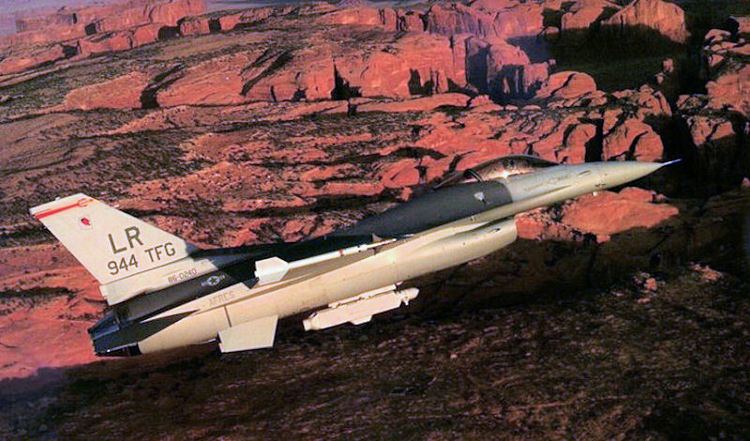Motto(s) Werewolves | Type Training | |
 | ||
Active 15 January 1941 – 27 January 194610 July 1952 – 1 July 195815 October 1969 – 16 March 19831 July 1983 - 2 February 20011 February 2010 – present Engagements World War II American TheaterWorld War II Asia-Pacific TheaterKorean War1991 Gulf War (Defense of Saudi Arabia; Liberation of Kuwait) | ||
The 69th Fighter Squadron (69 FS) is a United States Air Force Reserve fighter squadron. It is assigned to the 944th Operations Group, stationed at Luke Air Force Base, Arizona.
Contents
- World War II
- Korean War
- F 104 Training Unit
- Tactical Fighter Squadron
- Modern era
- Lineage
- Assignments
- References
The 69th Fighter Squadron replaced the 301st Fighter Squadron in 2010. It trains Air Force Reserve Command pilots combat tactics with the F-16 Fighting Falcon. It is integrated with the 56th Operations Group. The squadron flies Block 42 F-16Cs, tail code "LF", 69th FS carrying a black tail band.
World War II
Activated in 1941 as a single-engine fighter operational and replacement training unit, initially assigned to III Fighter Command, reassigned to I Fighter Command in 1942. Used P-39 Airacobras and P-40 Warhawks for training. Converted to an operational squadron, 1943, re-eqipped with P-47 Thunderbolts.
Deployed to South Pacific Area, 1943, being assigned to Thirteenth Air Force. Began combat operations in February 1944, providing protection for U.S. bases and escorting transports initially, then escorting bombers over New Guinea and sea convoys to Admiralty Islands. From Noemfoor, bombed and strafed Japanese airfields and installations on Ceram, Halmahera, and the Kai Islands.
Moved to the Philippines in Nov, flew fighter sweeps against enemy airfields, supported U.S. ground forces, and protected sea convoys and transport routes. Beginning in July 1945, attacked railways, airfields, and enemy installations in Korea and Kyushu, Japan from Okinawa.
After V-J Day, flew reconnaissance missions over Japan. Moved without personnel or equipment to the Philippines in December and demobilized, aircraft sent to depots in the Philippines, inactivated in January 1946.
Korean War
Reactivated at Tageu AB (K-2) South Korea in 1952, absorbing Federalized Texas Air National Guard personnel and F-84D Thunderjets. Squadron provided close air support for United Nations ground forces and attacked enemy airfields and installations. Transitioned in late 1952 to the new F-84G, designed with more speed and range. New targets included enemy ports, railroads, and airfields. The squadron attacked the major supply port of Sinuiju in September, inflicting heavy damage without loss of personnel or aircraft. Combining with other fighter-bomber units, it attacked the Kumgang Political School at Odong-ni in October 1952 and the North Korean tank and infantry school at Kangso in February 1953. In May, the 58th FBG bombed North Korean dams, flooding enemy lines of communication and rice fields. On 27 July 1953, attacked runway at Kanggye and, with the 49 FBG, bombed Sunan Airfield for the final action of fighter-bombers in the Korean War.
Re-equipped with F-86 Sabres after the 1953 armistice, remained in South Korea to enforce cease-fire with North Korea, squadron elements rotating frequently to Taiwan until inactivated in 1958 due to budget reductions.
F-104 Training Unit
Reactivated at Luke AFB, Arizona in October 1969 when the 58th Tactical Fighter Training Wing (TFTW) was activated, replacing the provisional 4510th CCTW as the host unit at Luke. Concurrently, the 69th Tactical Fighter Training Squadron (TFTS) and the 418th Tactical Fighter Training Squadron (TFTS) were activated as F-104G training units, replacing the provisional 4512th CCTS and 4518th CCTS to support Foreign Military Sales of the F-104. Pilots from Greece, Norway, Turkey, Denmark, and Spain were trained at Luke. In addition, many F-104Gs owned by the West German Luftwaffe actually operated with the 58th TFTW where they sported USAF insignia and carried USAF serial numbers.
Training of West German Air Force pilots in the F-104G continued until late 1982. The Germans flew more than 900 Starfighters totaling an excess of 269, 750 hours and produced 1,868 F-104 pilots. The 69th TFTS inactivated on 16 March 1983
Tactical Fighter Squadron
Reactivated as an F-4E Phantom II tactical fighter squadron at Moody AFB, Georgia on 1 July 1983, assuming the personnel and aircraft of the 339th Tactical Fighter Squadron which inactivated the same day. Tail coded "MY", carried a silver/red tail stripe. Conducted frequent exercise deployments in the U.S. and overseas to maintain capabilities specializing in air-to-ground attack using precision-guided weapons. Transitioned to F-16A/B aircraft, 1988–1989, and oriented mission planning toward NATO requirements by conducting squadron-strength deployments to Europe. Began upgrading to F-16C/D in Jan 1990 and in Aug 1990 became first operational TAC unit to employ the LANTIRN all-weather/night navigation and bombing system.
Deployed to Southwest Asia, January–February 1991, engaging in combat operations during Operation Desert Storm flying more than 1,500 combat sorties. Following the ceasefire, continued to support peace-keeping operations with periodic aircraft deployments to Saudi Arabia. Continued training operations from Moody AFB throughout the 1990s, stood down in early 2001 when Moody was realigned to a Rescue/Special Operations base and host 347th Fighter Wing was inactivated.
Modern era
Reactivated in February 2010 at Luke AFB in the Air Force Reserve with a mission to train Air Force Reserve Command pilots in combat tactics with the F-16 Fighting Falcon.
